Page 114 of 574
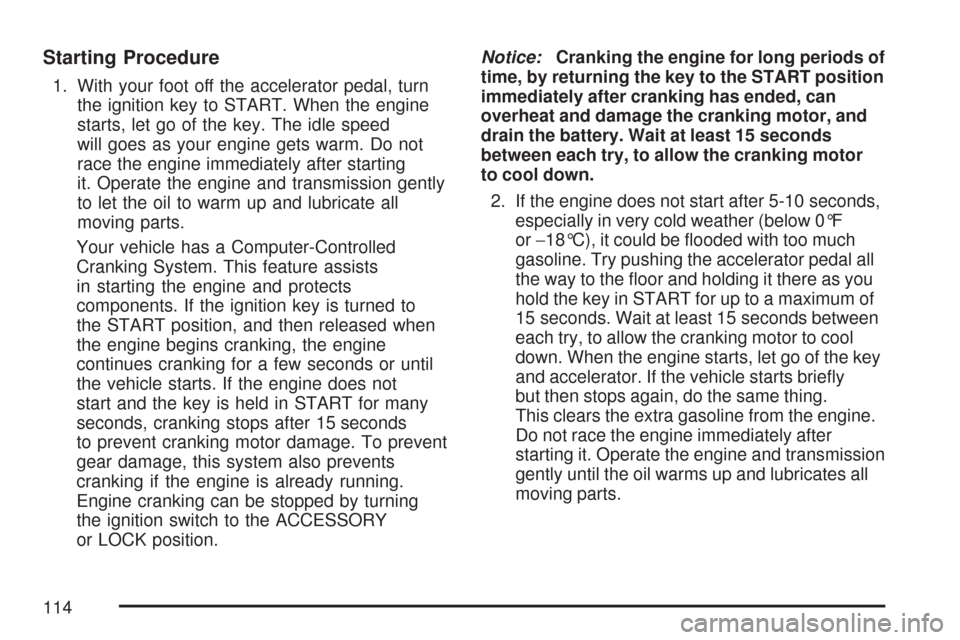
Starting Procedure
1. With your foot off the accelerator pedal, turn
the ignition key to START. When the engine
starts, let go of the key. The idle speed
will goes as your engine gets warm. Do not
race the engine immediately after starting
it. Operate the engine and transmission gently
to let the oil to warm up and lubricate all
moving parts.
Your vehicle has a Computer-Controlled
Cranking System. This feature assists
in starting the engine and protects
components. If the ignition key is turned to
the START position, and then released when
the engine begins cranking, the engine
continues cranking for a few seconds or until
the vehicle starts. If the engine does not
start and the key is held in START for many
seconds, cranking stops after 15 seconds
to prevent cranking motor damage. To prevent
gear damage, this system also prevents
cranking if the engine is already running.
Engine cranking can be stopped by turning
the ignition switch to the ACCESSORY
or LOCK position.Notice:Cranking the engine for long periods of
time, by returning the key to the START position
immediately after cranking has ended, can
overheat and damage the cranking motor, and
drain the battery. Wait at least 15 seconds
between each try, to allow the cranking motor
to cool down.
2. If the engine does not start after 5-10 seconds,
especially in very cold weather (below 0°F
or−18°C), it could be �ooded with too much
gasoline. Try pushing the accelerator pedal all
the way to the �oor and holding it there as you
hold the key in START for up to a maximum of
15 seconds. Wait at least 15 seconds between
each try, to allow the cranking motor to cool
down. When the engine starts, let go of the key
and accelerator. If the vehicle starts brie�y
but then stops again, do the same thing.
This clears the extra gasoline from the engine.
Do not race the engine immediately after
starting it. Operate the engine and transmission
gently until the oil warms up and lubricates all
moving parts.
114
Page 115 of 574
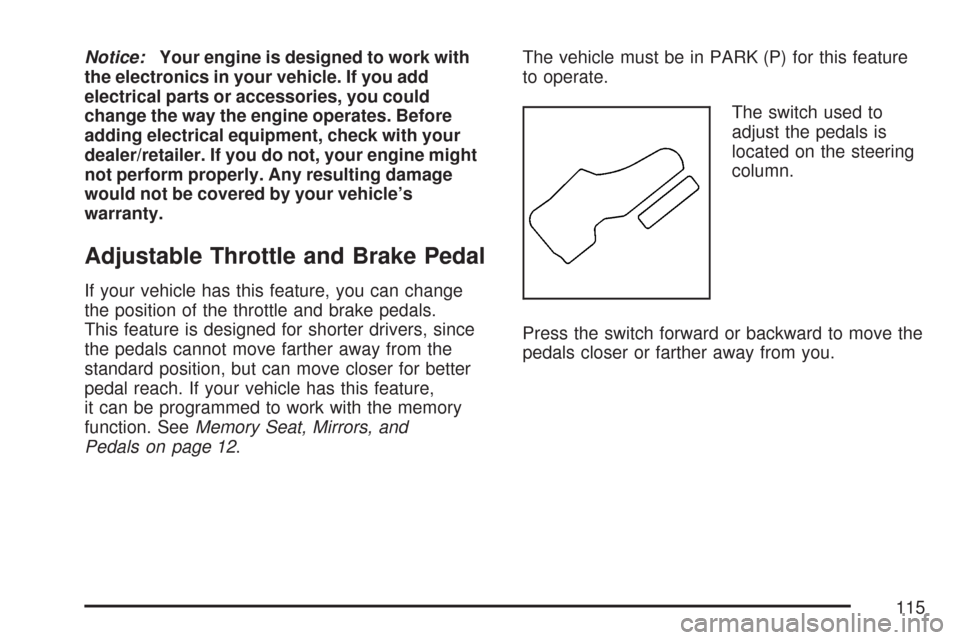
Notice:Your engine is designed to work with
the electronics in your vehicle. If you add
electrical parts or accessories, you could
change the way the engine operates. Before
adding electrical equipment, check with your
dealer/retailer. If you do not, your engine might
not perform properly. Any resulting damage
would not be covered by your vehicle’s
warranty.
Adjustable Throttle and Brake Pedal
If your vehicle has this feature, you can change
the position of the throttle and brake pedals.
This feature is designed for shorter drivers, since
the pedals cannot move farther away from the
standard position, but can move closer for better
pedal reach. If your vehicle has this feature,
it can be programmed to work with the memory
function. SeeMemory Seat, Mirrors, and
Pedals on page 12.The vehicle must be in PARK (P) for this feature
to operate.
The switch used to
adjust the pedals is
located on the steering
column.
Press the switch forward or backward to move the
pedals closer or farther away from you.
115
Page 116 of 574
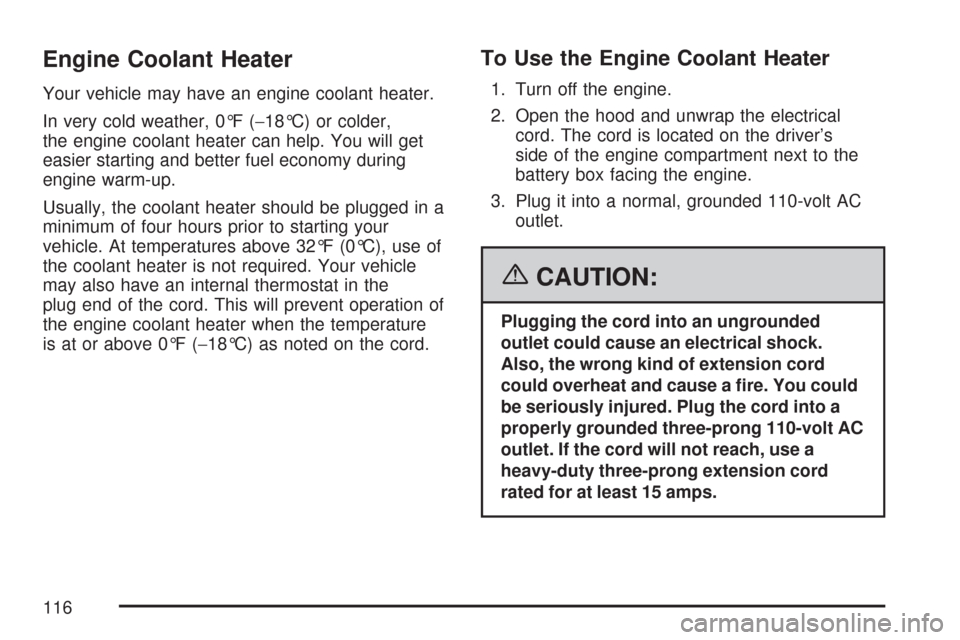
Engine Coolant Heater
Your vehicle may have an engine coolant heater.
In very cold weather, 0°F (−18°C) or colder,
the engine coolant heater can help. You will get
easier starting and better fuel economy during
engine warm-up.
Usually, the coolant heater should be plugged in a
minimum of four hours prior to starting your
vehicle. At temperatures above 32°F (0°C), use of
the coolant heater is not required. Your vehicle
may also have an internal thermostat in the
plug end of the cord. This will prevent operation of
the engine coolant heater when the temperature
is at or above 0°F (−18°C) as noted on the cord.
To Use the Engine Coolant Heater
1. Turn off the engine.
2. Open the hood and unwrap the electrical
cord. The cord is located on the driver’s
side of the engine compartment next to the
battery box facing the engine.
3. Plug it into a normal, grounded 110-volt AC
outlet.
{CAUTION:
Plugging the cord into an ungrounded
outlet could cause an electrical shock.
Also, the wrong kind of extension cord
could overheat and cause a �re. You could
be seriously injured. Plug the cord into a
properly grounded three-prong 110-volt AC
outlet. If the cord will not reach, use a
heavy-duty three-prong extension cord
rated for at least 15 amps.
116
Page 117 of 574
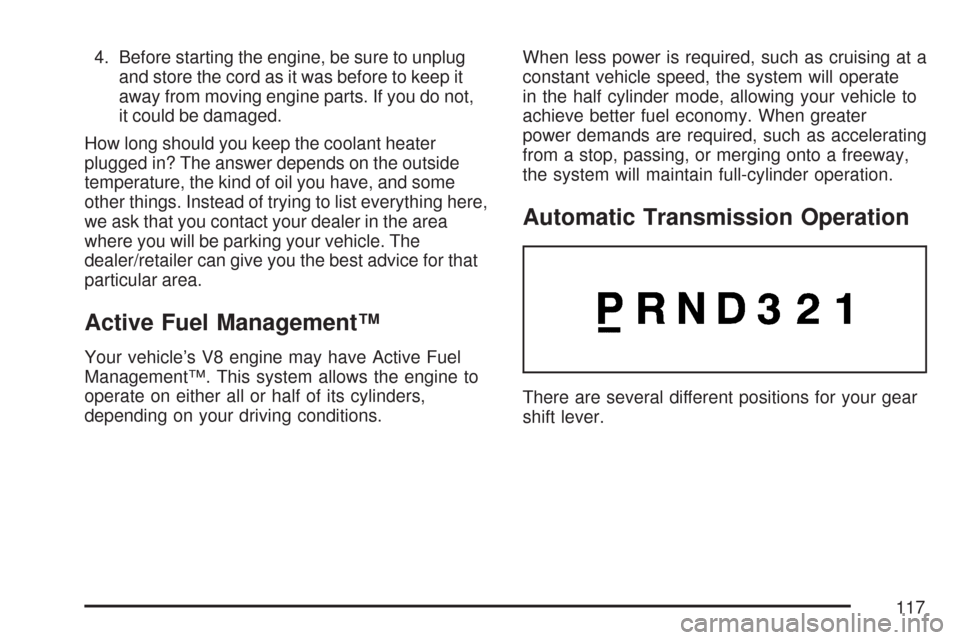
4. Before starting the engine, be sure to unplug
and store the cord as it was before to keep it
away from moving engine parts. If you do not,
it could be damaged.
How long should you keep the coolant heater
plugged in? The answer depends on the outside
temperature, the kind of oil you have, and some
other things. Instead of trying to list everything here,
we ask that you contact your dealer in the area
where you will be parking your vehicle. The
dealer/retailer can give you the best advice for that
particular area.
Active Fuel Management™
Your vehicle’s V8 engine may have Active Fuel
Management™. This system allows the engine to
operate on either all or half of its cylinders,
depending on your driving conditions.When less power is required, such as cruising at a
constant vehicle speed, the system will operate
in the half cylinder mode, allowing your vehicle to
achieve better fuel economy. When greater
power demands are required, such as accelerating
from a stop, passing, or merging onto a freeway,
the system will maintain full-cylinder operation.
Automatic Transmission Operation
There are several different positions for your gear
shift lever.
117
Page 118 of 574
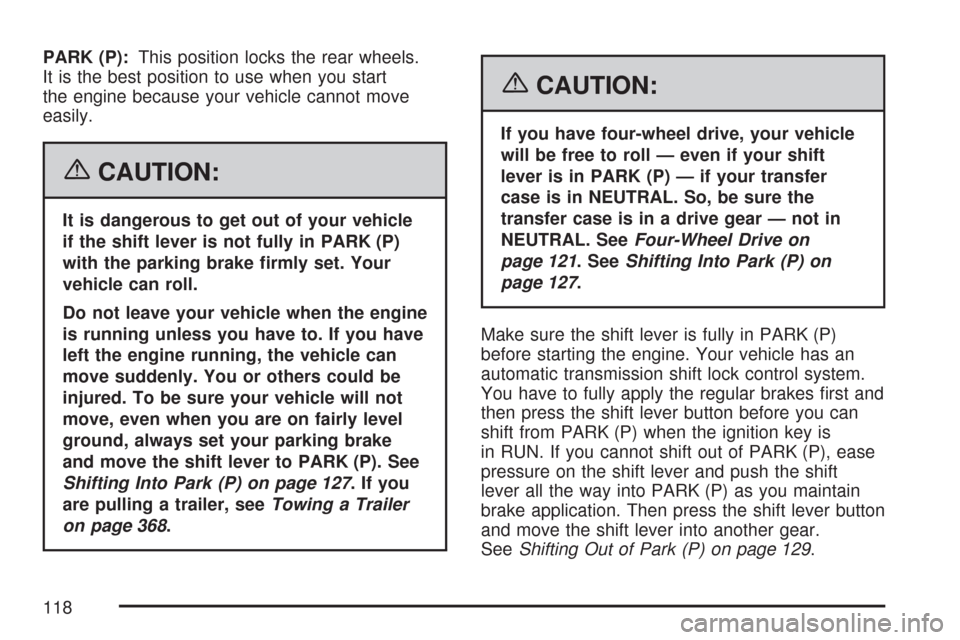
PARK (P):This position locks the rear wheels.
It is the best position to use when you start
the engine because your vehicle cannot move
easily.
{CAUTION:
It is dangerous to get out of your vehicle
if the shift lever is not fully in PARK (P)
with the parking brake �rmly set. Your
vehicle can roll.
Do not leave your vehicle when the engine
is running unless you have to. If you have
left the engine running, the vehicle can
move suddenly. You or others could be
injured. To be sure your vehicle will not
move, even when you are on fairly level
ground, always set your parking brake
and move the shift lever to PARK (P). See
Shifting Into Park (P) on page 127.Ifyou
are pulling a trailer, seeTowing a Trailer
on page 368.
{CAUTION:
If you have four-wheel drive, your vehicle
will be free to roll — even if your shift
lever is in PARK (P) — if your transfer
case is in NEUTRAL. So, be sure the
transfer case is in a drive gear — not in
NEUTRAL. SeeFour-Wheel Drive on
page 121. SeeShifting Into Park (P) on
page 127.
Make sure the shift lever is fully in PARK (P)
before starting the engine. Your vehicle has an
automatic transmission shift lock control system.
You have to fully apply the regular brakes �rst and
then press the shift lever button before you can
shift from PARK (P) when the ignition key is
in RUN. If you cannot shift out of PARK (P), ease
pressure on the shift lever and push the shift
lever all the way into PARK (P) as you maintain
brake application. Then press the shift lever button
and move the shift lever into another gear.
SeeShifting Out of Park (P) on page 129.
118
Page 119 of 574
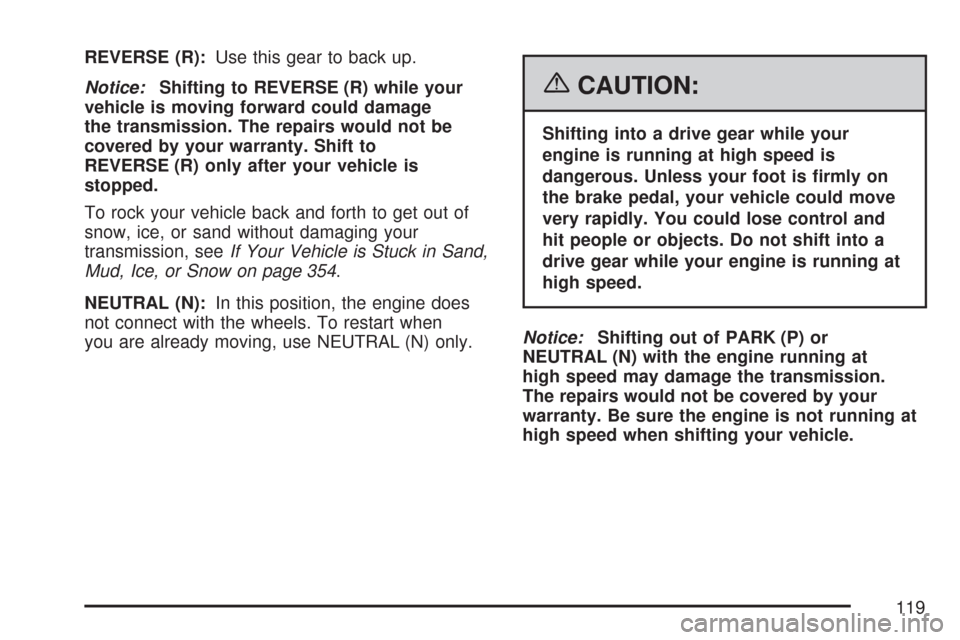
REVERSE (R):Use this gear to back up.
Notice:Shifting to REVERSE (R) while your
vehicle is moving forward could damage
the transmission. The repairs would not be
covered by your warranty. Shift to
REVERSE (R) only after your vehicle is
stopped.
To rock your vehicle back and forth to get out of
snow, ice, or sand without damaging your
transmission, seeIf Your Vehicle is Stuck in Sand,
Mud, Ice, or Snow on page 354.
NEUTRAL (N):In this position, the engine does
not connect with the wheels. To restart when
you are already moving, use NEUTRAL (N) only.
{CAUTION:
Shifting into a drive gear while your
engine is running at high speed is
dangerous. Unless your foot is �rmly on
the brake pedal, your vehicle could move
very rapidly. You could lose control and
hit people or objects. Do not shift into a
drive gear while your engine is running at
high speed.
Notice:Shifting out of PARK (P) or
NEUTRAL (N) with the engine running at
high speed may damage the transmission.
The repairs would not be covered by your
warranty. Be sure the engine is not running at
high speed when shifting your vehicle.
119
Page 121 of 574
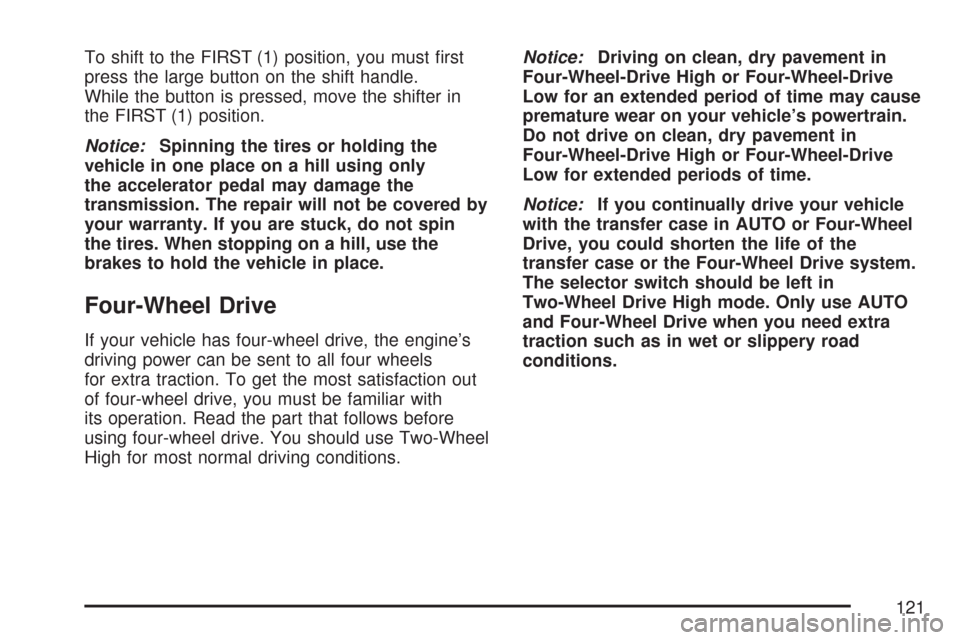
To shift to the FIRST (1) position, you must �rst
press the large button on the shift handle.
While the button is pressed, move the shifter in
the FIRST (1) position.
Notice:Spinning the tires or holding the
vehicle in one place on a hill using only
the accelerator pedal may damage the
transmission. The repair will not be covered by
your warranty. If you are stuck, do not spin
the tires. When stopping on a hill, use the
brakes to hold the vehicle in place.
Four-Wheel Drive
If your vehicle has four-wheel drive, the engine’s
driving power can be sent to all four wheels
for extra traction. To get the most satisfaction out
of four-wheel drive, you must be familiar with
its operation. Read the part that follows before
using four-wheel drive. You should use Two-Wheel
High for most normal driving conditions.Notice:Driving on clean, dry pavement in
Four-Wheel-Drive High or Four-Wheel-Drive
Low for an extended period of time may cause
premature wear on your vehicle’s powertrain.
Do not drive on clean, dry pavement in
Four-Wheel-Drive High or Four-Wheel-Drive
Low for extended periods of time.
Notice:If you continually drive your vehicle
with the transfer case in AUTO or Four-Wheel
Drive, you could shorten the life of the
transfer case or the Four-Wheel Drive system.
The selector switch should be left in
Two-Wheel Drive High mode. Only use AUTO
and Four-Wheel Drive when you need extra
traction such as in wet or slippery road
conditions.
121
Page 124 of 574
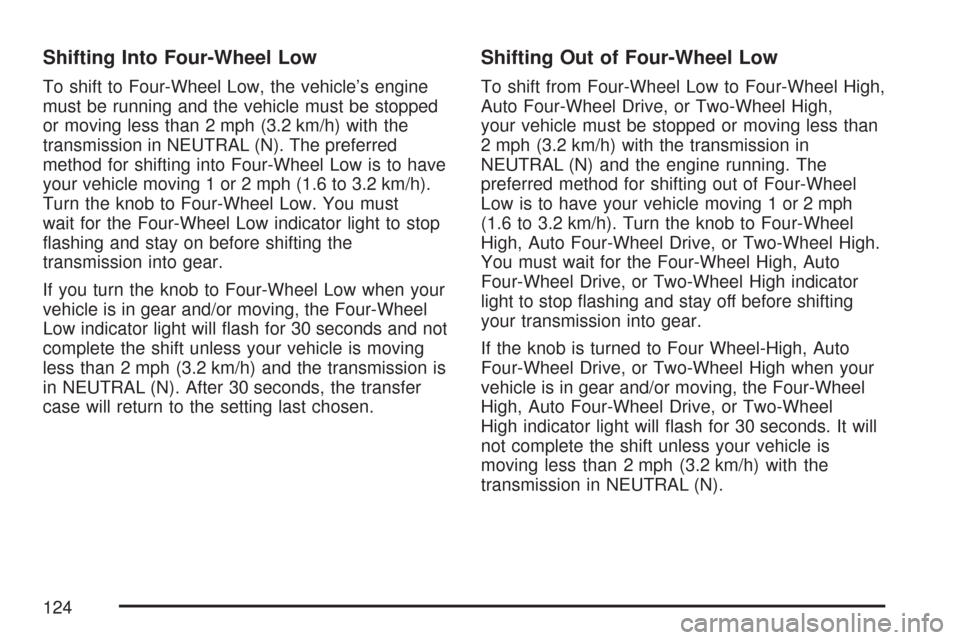
Shifting Into Four-Wheel Low
To shift to Four-Wheel Low, the vehicle’s engine
must be running and the vehicle must be stopped
or moving less than 2 mph (3.2 km/h) with the
transmission in NEUTRAL (N). The preferred
method for shifting into Four-Wheel Low is to have
your vehicle moving 1 or 2 mph (1.6 to 3.2 km/h).
Turn the knob to Four-Wheel Low. You must
wait for the Four-Wheel Low indicator light to stop
�ashing and stay on before shifting the
transmission into gear.
If you turn the knob to Four-Wheel Low when your
vehicle is in gear and/or moving, the Four-Wheel
Low indicator light will �ash for 30 seconds and not
complete the shift unless your vehicle is moving
less than 2 mph (3.2 km/h) and the transmission is
in NEUTRAL (N). After 30 seconds, the transfer
case will return to the setting last chosen.
Shifting Out of Four-Wheel Low
To shift from Four-Wheel Low to Four-Wheel High,
Auto Four-Wheel Drive, or Two-Wheel High,
your vehicle must be stopped or moving less than
2 mph (3.2 km/h) with the transmission in
NEUTRAL (N) and the engine running. The
preferred method for shifting out of Four-Wheel
Low is to have your vehicle moving 1 or 2 mph
(1.6 to 3.2 km/h). Turn the knob to Four-Wheel
High, Auto Four-Wheel Drive, or Two-Wheel High.
You must wait for the Four-Wheel High, Auto
Four-Wheel Drive, or Two-Wheel High indicator
light to stop �ashing and stay off before shifting
your transmission into gear.
If the knob is turned to Four Wheel-High, Auto
Four-Wheel Drive, or Two-Wheel High when your
vehicle is in gear and/or moving, the Four-Wheel
High, Auto Four-Wheel Drive, or Two-Wheel
High indicator light will �ash for 30 seconds. It will
not complete the shift unless your vehicle is
moving less than 2 mph (3.2 km/h) with the
transmission in NEUTRAL (N).
124